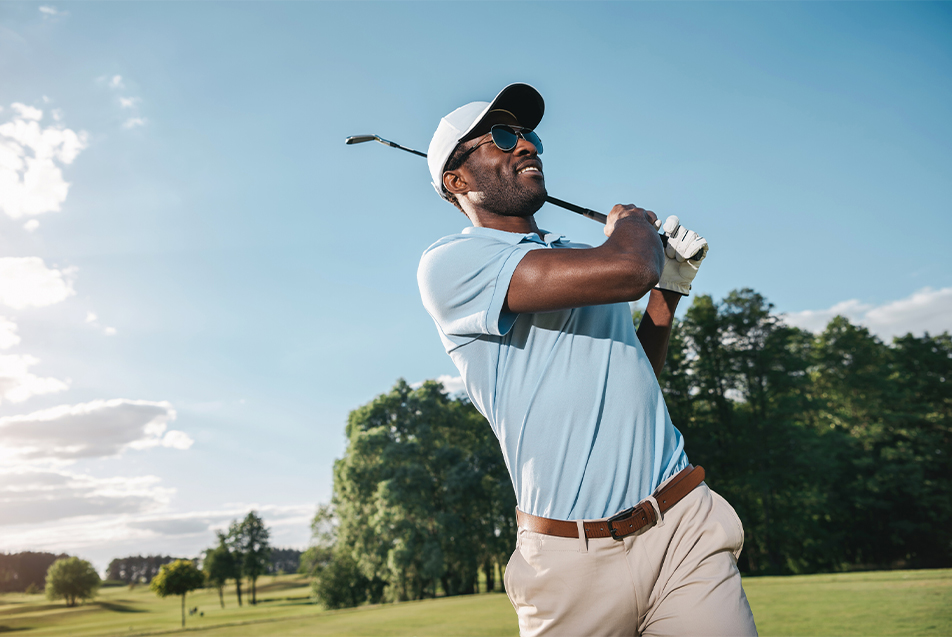
Golf is often seen as a passive sport, not requiring much physical fitness. But, in truth, it actually incorporates cardiovascular exercise, strength training, balance and even coordination, to name a few. And, while you may not realize it, everything from your posture down to how you move your body can affect your golf game. So, we turned to Zach Nagel, ATC, CSCS, human performance specialist, Parkview Sports Medicine. As a Titleist Performance Institute®-certified golf fitness instructor, we asked Zach to elaborate more on the benefits of establishing a golf fitness program and what it can do for an athlete’s body and their game.
What is golf fitness?
From a performance training perspective, golf fitness is the preparation of your body for playing golf. In the same way that you would prepare yourself to run a race or get in shape to play a sport, you need to prepare your body to play golf.
For professionals or competitive golfers, this could mean developing their physical fitness to maintain peak performance throughout an entire round, week after week, for the whole season. For recreational golfers, golf fitness means having all the different ranges of motion necessary to swing consistently and reduce the risk of injury. However, no matter your experience or skill level, all golfers can benefit from golf fitness training.
What are the benefits of a golf fitness program?
A golf fitness program prepares you for the demands of the sport. Because golf isn’t necessarily a high-speed, contact sport, it may be easy to overlook the physical demands of a round of golf. However, the sport can be physically complex and demanding in that it utilizes various muscle groups and parts of the body that must work together on each swing.
Should you choose to engage in a golf fitness program, it can benefit you in the following ways:
- Improve your range of motion: The ability to move your body properly is the most significant benefit of a golf fitness program – even more than physical strength. A single golf swing requires a full range of motion in the shoulders, back, hips and hands. A golf fitness program helps improve and maintain each of these motions.
- Increase your total body strength: A successful, consistent golf swing requires strength for stabilizing the lower body while rotating the trunk and upper body. Building total body strength comes second only to range of motion when it comes to golf fitness.
Without an adequate range of motion or total body strength, golfers can be susceptible to injuries from the repetitive motions of each swing. For example, poor range of motion in the shoulders can put more strain on your back. Additionally, a lack of core and lower body strength can cause other muscles to compensate and result in strains, sprains and other injuries.
What are some common injuries a golf fitness program can help prevent?
Golf can put a tremendous about of strain and stress on the body, resulting in nagging injuries. Some of the most common ailments can include:
- Lower back injuries: The most common complaint or injury we see with golfers is chronic back pain. This is often the result of poor range of motion in the hips or core, weakness in the hips and a lack of core stability.
- Shoulder and rotator cuff injuries: These often occur because of overuse and improper swing mechanics. A lack of range of motion puts more stress on the shoulder joint and rotator cuff muscles as you accelerate and decelerate through each swing.
- Hip injuries: Similar to your shoulders, the hips are subject to tremendous force and range of motion throughout a golf swing. A golfer’s hips must have the ability to rotate internally and externally, shift weight and transfer power from the back leg to the front leg. If a person’s range of motion or strength is not adequate, they risk injuring different muscles in the hips.
Fortunately, golf fitness programs help address each of these potential weaknesses, building a player’s range of motion and total body strength so they can perform better, play longer and reduce their risk of injury.
What kind of results can someone expect from a golf fitness program?
Typically, you can expect a better swing and reduced risk of injury with a golf fitness program. At Parkview, all our golf fitness programs begin with a one-on-one assessment, so we can learn more about what you want to accomplish.
Physically, a good golf swing comes from establishing the necessary range of motion and physical strength to repeat that swing repeatedly. In the past, the prevailing thought was that “better swing” meant that you must swing a certain way (like Jack Nicklaus or Tiger Woods). Now, the Titleist Performance Institute® states that they don’t believe there’s only one swing style, but instead an infinite number of them based on your physical skills. Our job is to help build the best swing for you, not teach you to swing a certain way.
If you’re interested in learning more about golf fitness, please contact Parkview Sports Medicine at 260-266-4007, or schedule a consultation here.



